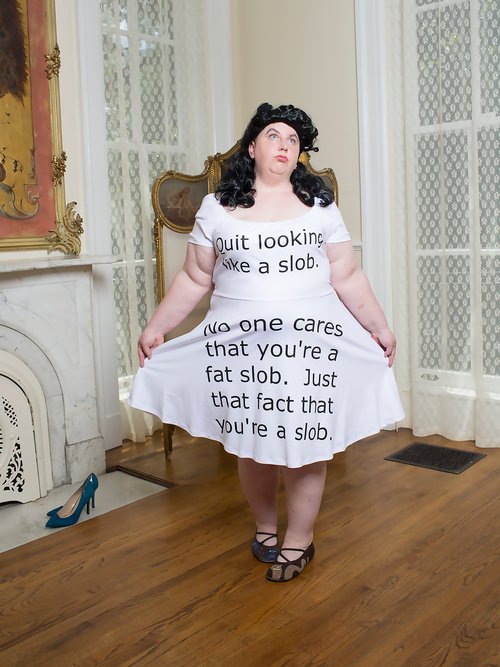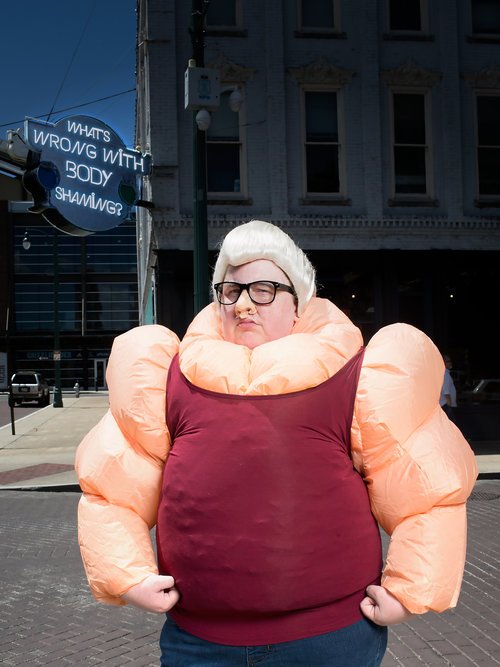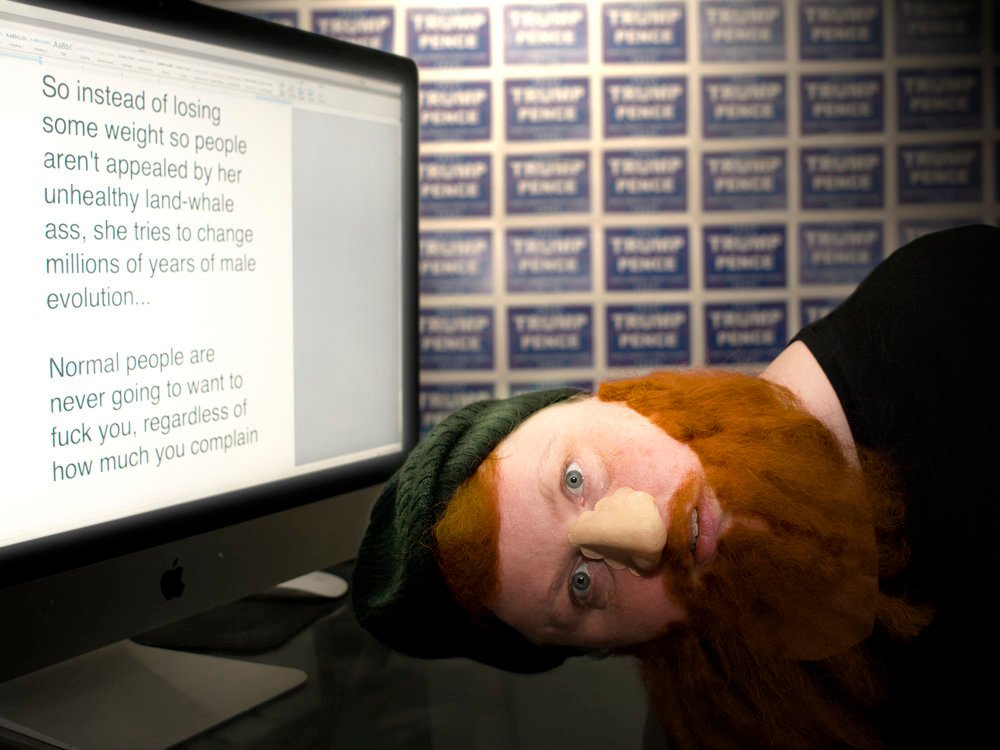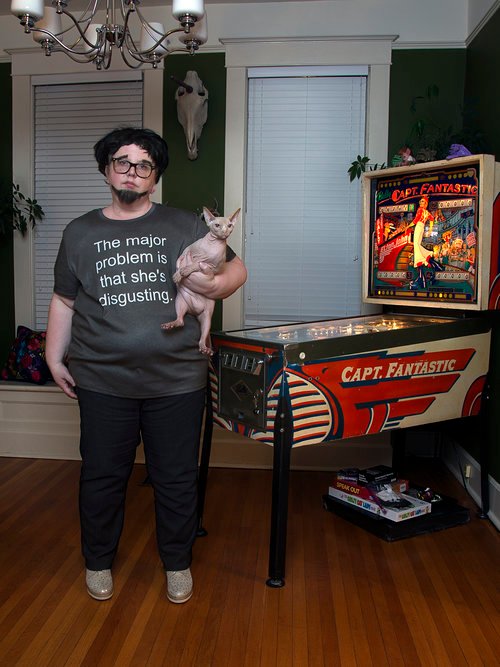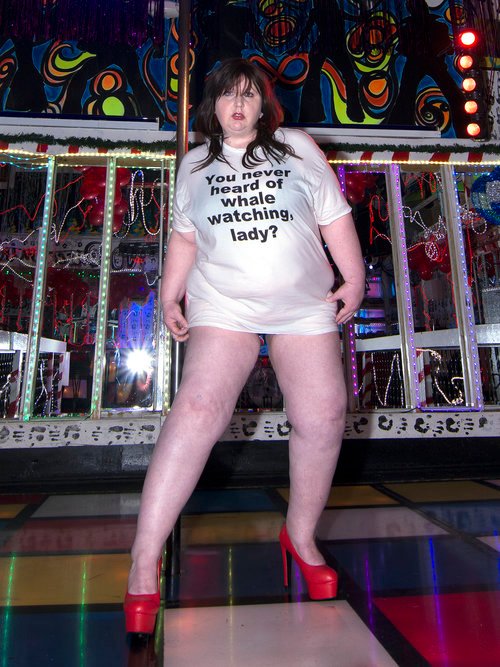Giangiacomo Cirla: I want to start this dialogue by asking you something about your work and the distinctive characters of your research and approach. Let’s talk about your two series, “Wait Watchers” and “The Bully Pulpit”. How did you start them and what are they investigating?
Haley Morris-Cafiero: “Wait Watchers” started serendipitously while I was working on an earlier self portrait project. I set up a camera in Times Square in New York City and after I got the film developed, I noticed that a man appeared to be sneering at me. And then it happened on the same roll of film a few minutes later, I knew that I needed to explore it. It became a social experiment to see what happened if I photograph people in public while I perform mundane tasks. I have to say that I do not know what the strangers in the photos are thinking or reacting to, the project became about how people use their gaze to communicate our opinions about others and how we determine our self worth by how others look at us.
When “Wait Watchers” went viral from 2013-2015, I received thousands of messages from people who tried to get me to stop doing my work by telling me how ugly and fat I am, how my look is ruining society and how I am going to die soon and alone because of the way that I look. The idea of a bully sitting behind a screen trying to use the internet as a weapon to try to stop my voice amused me from the beginning. I knew that I wanted to respond to the bullies but if I responded to them with text, they would delete it or it would fuel their hatred even more. Then I realized that an image cannot be removed from the internet so I needed to respond photographically.
I found the public profiles of 25 of my cyber bullies and I costume myself to look like them and insert their hateful words into the photograph. This project is called “The Bully Pulpit” and it is my response to thousands of bullies who tried to quiet my voice by making me hate myself. I use very poor prosthetics and props to elude to the fact that the internet is a false sense of security for those who are using it to spread hate.
GC: You use the medium of photography as evidence of an event in which you are a participant and the trigger. Through an overproduction of images you create a mapping from which extract elements to reconstruct a narrative suitable to tell the performance itself combined with the research you are carrying out. Which criteria guide your selection?
HMC: For “Wait Watchers” I chose the images that gave me a subtle feeling of being looked at. There were images that showed people obviously making gestures at me. But those are too easy. I like to start the conversation and let the viewer take their position. For “The Bully Pulpit” I chose 25 bullies from a diverse demographic: aged 13 to 70, men and women from all over the world.
GC: How much does the fact of being the subject of judgments affect the selection of images?
HMC: When I am selecting the images, I think of my role as very objective. Meaning, while they are self-portraits, I am the representation of someone who exists outside of society’s ideal image.
GC: When you staged your performance, did you know what would happen? Or rather, when you selected the images that make up your work, were you more surprised by what you saw or saddened by the predictability of a known behavior?
HMC: For “Wait Watchers,” when I did a performance, I would do mundane performances that would fit into the scene. So I had no idea at the time of taking the photo, if there would be any successful ones for the project. When I found successful images, I was fueled to make more.
GC: Speaking of successful images, what is the percentage of them suitable for this project within the entire documentation produced. How many images are discarded, those in which there are no particular attitudes to report?
HMC: It is hard to say but the percentage. The “Wait Watchers” series is made up of 60 images out of thousands of images that were taken over 5 years.
GC: Roland Barthes says that through the gaze of others, the ego, taken in its uniqueness, is defined in a way and in a world that is new to him, is given a new unknown guise, but perceived. Through the photographic medium you make visible the glances, free to express themselves as apparently not observed, which otherwise would be impossible for us to observe. What happens while we do something else, when we look at others and others look at us. Is it correct to define your work a documentary on the invisible, what happens while you focus your attention on other and that normally would not enter into your life experience?
HMC: I think that is one way to difine the series. What I love about “Wait Watchers” is that can live in so many genres. It is technically street photography, documentary, self-portrait, conceptual, performative and guerilla all at once.
GC: The possibility to observe the looks of passersby in relation to your body what reflections has generated in you?
HMC: If anything it has made me more confident in my ability to do performance based work.
GC: Looking at your images we can see how the behaviors become more and more invasive with the increase of the people involved. How much does the sharing of judgments with other spectators influence this behavior, how important is the herd effect in the act of judging?
HMC: Again, I have to be clear that I do not know what the people in the photographs are thinking or reacting to. When the project went viral, the hateful commenting had a herd effect as when one person made a comment, others would join.
GC: Maybe because the more you feel protected and far away, defended by a possible retaliation, and the more wickedness and arrogance with which the judgment is expressed increases, in “The Bully Pulpit” we see how the internet environment exasperates certain aspects of individuals. It expands the knowledge of those who love to seek, the sociality of those who want to socialize and at the same time increases the wickedness and the will of prevarication of people brought to such attitudes. Cyberbullying is a representation of it as an exasperated form of a prevaricating attitude that can now be conveyed without geographical limits and without any fear of being denied, strong in its own small voice that, amplified by digital social dynamics, acquires a huge megaphone…
HMC: I think it is up to us to prove that statement wrong. Meaning we need to stifle the hateful voices by making the more positive voices louder. And show the cyberbullies that they aren’t hidden when they say those hateful things. If you assume that cyberbullies are using the internet because it provides them with distance and anonymity, then we need to show them that it doesn’t. Which is why I did “The Bully Pulpit.”
GC: The comments you received following the virality of “Wait Watchers” thus become an integral part of the next chapter (The Bully Pulpit). They are highlighted as a collective response through the use of the medium that attracted these criticisms. The virality guaranteed by the internet allows you to take the content of the received comment and, adding a shape, makes it a signifier. Why did you decide to use this reversal methodology?
HMC: Because I wanted to out-smart and out-wit the people who were attacking me. It would have been easy to publish their names, addresses, etc.. But that would have been easy. We would have looked at the information and then reacted and then move on. But by taking advantage of the fact that they do not own their likeness, I am using it to amplify my voice. Their constructed image is very important to these people and I am using it to show the world what they say about me – and others.
GC: What response did this project generate?
HMC: I wanted to be much more intentional with the publication of The Bully Pulpit. Meaning, I am an artist and not a media personality so I wanted to be very selective with whom I work with regarding media for the project. It has been well received and exhibited in several shows so far.
GC: I find your work really interesting because it manages to create a deep reflection through didactic images, capable of being read by many and carriers of an immediacy that is hardly replicable through other media. How important is the use of photography as a means of communication?
HMC: I use photography as a tool to document a performance. More specifically, one moment within the performance. Photography allows me to extract that moment and present it alone rather than video which provides the before and the after.
GC: What will be the next step? Are you already working on it?
HMC: I have committed to completing 3-4 projects by mid-September. Collaborating with the people who emailed me positive messages when Wait Watchers went viral. Many of these people had a life changing moment when seeing Wait Watchers online and I want to explore that using self-portraits in environments constructed out of my collaborators images and texts. Ground Breaking – using methods of “The Bully Pulpit” to challenge people with power in the art world.
Many times I have been told offensive things by prominent people in the art world but never said anything because of their perceived power. I am going to costume myself to look like them and insert their ridiculous comment in the photo. A project that explores the social invisiblity that is felt by many groups who live in Luton, a city North of London.
Applying for funding support to do a project about social and professional invisibilty of people who exist outside of society’s ideal image. I was a finalist for the BMW Resdience award for the project and am now looking for any opportunity to do the project next summer.
Part performer, part artist, part provocateur, part spectator, Haley Morris-Cafiero explores the act of reflection in her photography. Morris-Cafiero’s photographs have been widely exhibited in solo and group exhibitions throughout the United States and abroad, and have been featured in numerous newspapers, magazines and online including Le Monde, New York Magazine and Salon. Born in Atlanta, she is a graduate of the University of North Florida, where she earned a BA in Photography and a BFA in Ceramics in 1999. Nominated for the Prix Pictet in 2014 and a 2016 Fulbright finalist, Morris-Cafiero holds a MFA from the University of Arizona in Art. The Magenta Foundation published her monograph, The Watchers, in 2015.







